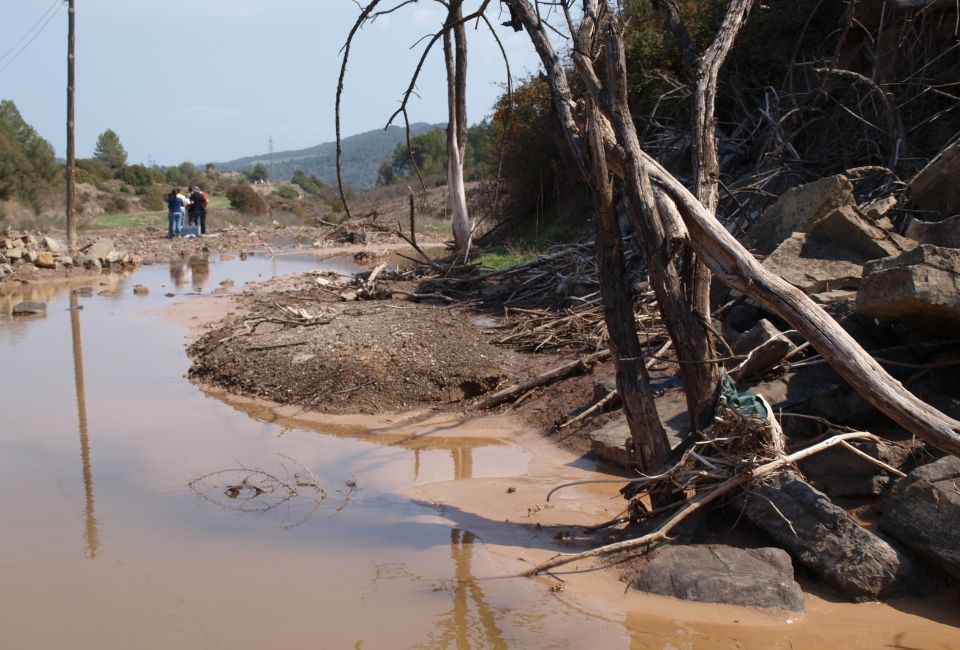
A study by Miguel Cañedo-Argüelles outlines the global map of river salinisation: one in three in Spain is affected
One in three rivers on the Iberian Peninsula is salinised, mainly due to the impact of agriculture and urbanisation. This environmental problem will have an increasing effect on water ecosystems around the world due to global warming, rising water consumption levels, and the exploitation of natural land resources. These are some of the issues highlighted in the special volume on the salinisation of water ecosystems, published this December in the journal Philosophical Transactions of the Royal Society B, and edited by the experts Miguel Cañedo-Argüelles, a researcher at the Beta Technology Centre at the UVic-UCC, a member of the Freshwater Ecology, Hydrology and Management (FEHM-UB) research group, and the Water Institute (IdRA) of the University of Barcelona (UB), Ben Kefford (University of Canberra, Australia) and Ralf B. Schäfer (University of Landau, Germany).
Other authors participating in the study are the FEHM-UB researchers Núria Bonada (UB-IRBio), Cayetano Gutiérrez-Cánovas, Raúl Acosta and Pau Fortuño; Neus Otero and Albert Soler, of the Applied Mineralogy and Environment Research Group (MAiMA) of the Faculty of Earth Sciences at the UB; David Suari and Santiago Gorostiza (UAB), and experts from the Institute of Environmental Hydraulics at the University of Cantabria, the University of Murcia, the University of Castilla-La Mancha and the Institute of Natural Products and Agrobiology (IPNA- CSIC) of the Canary Islands, among others.
Rivers with excess salt: the human factor
Salinisation is a serious environmental threat worldwide, with Australian rivers providing some of the most extreme cases. In Europe, salinisation related to human activity is an increasing concern, but there is still a lack of regulatory guidelines. On the Iberian Peninsula, the map of the rivers affected by salinisation - currently one-third of all river systems - will be increasingly large, according to the new study that examines the main causes of salinisation and makes predictions for the scenarios of climate change and different land uses. In some river basins on the peninsula, such as the Soldevilla stream in Sallent, the plain of the river Ebro, and the Murcia region, some rivers' salinity levels are three or four times higher than the sea.
High salinisation levels in river systems have a serious ecological, economic and global health impact, which in some cases is related to the concentration of carcinogens in the water or metals released due to corrosion of piping. Mining, agriculture and livestock farming and changes in rainfall levels, which limit rivers' ability to dilute salt, are the main salinisation threats to the environmental health of rivers.
As well as damaging the systemic values of natural ecosystems, salinisation makes water purification more expensive. It directly affects biodiversity and the functioning of aquatic ecosystems, causes changes in the typical riverside forest landscape, and alters the physiology of aquatic insects. "However, we need a great deal more basic information on organisms, communities and ecosystems to predict its effects", says Miguel Cañedo-Argüelles, and adds that "it will only be possible to produce efficient models that enable us to predict and mitigate the effects of salinisation on water ecosystems when we have this basic information."
How can we change the response in salinised rivers?
The new study reviews the effects that can change water systems' responses to salinisation. "There are three basic factors to consider: the synergy with other factors that can interact with salinisation (such as rising temperatures, pollution from metals, etc.); the ionic composition of the water - different ions have different levels of toxicity - and biogeographic factors (nearby rivers that have not been salinised that can provide a source for colonising organisms) and evolutionary factors (generated a population of salt-resistant organisms)," says Cañedo-Argüelles.
Maximum levels of ion concentrations in rivers must be established
The increase in salt mines in Germany during the 1950s had a major impact on the ecology of the country's rivers (particularly the Werra and the Wipper). The new study shows how these episodes of extreme salinisation in water ecosystems in Germany - which were reviewed in the scientific bibliography by Schulz and Cañedo-Argüelles - led the massive death of fish populations and the flourishing of toxic algae, among other environmental impacts. Today, some progress has been made in countries including Australia and the United States to regulate the level of salinisation in rivers, but the level of protection is still insufficient.
"Current legislation on salinisation in aquatic ecosystems is clearly excessive lax and incomplete, and we still lack many efficient management measures," insists Cañedo-Argüelles. He concludes that "the most important and urgently needed management measure is to establish concentration limits of ions in water to protect biodiversity and the health of water ecosystems. The collaboration of all the parties involved must be enhanced to implement the appropriate preventive and management measures, and thereby preserve the environmental health of river systems which are threatened by the serious problem of salinisation."